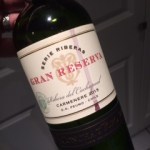 The Carmenere grape has a long history, and was a standard part of a typical Bordeaux blend up until the mid-1800s. Then the Phylloxera scourge hit Europe, and much of the existing vineyards were devastated. When the industry recovered using new, Phylloxera resistant rootstock, the Carmenere grape was sort of forgotten in Bordeaux. They did not widely re-graft it and today it is not one of the five grapes that typically find their way into your red claret.
The Carmenere grape has a long history, and was a standard part of a typical Bordeaux blend up until the mid-1800s. Then the Phylloxera scourge hit Europe, and much of the existing vineyards were devastated. When the industry recovered using new, Phylloxera resistant rootstock, the Carmenere grape was sort of forgotten in Bordeaux. They did not widely re-graft it and today it is not one of the five grapes that typically find their way into your red claret.
Many Bordeaux varietals were introduced into Chile in the 1800s, prior to the Phylloxera calamity, and they thrived. Carmenere was one of them. In Chile there is a guarded micro-climate, with desert to the north, the Andes mountains all along the eastern border, the ice fields to the far south and the Pacific Ocean to the west. Phylloxera never made it here. Today, Carmenere is one of the major grapes in what has become a well respected country for the production of premium wines.
Surprisingly, up until 1994, many Carmenere vines were mistakenly believed to be a local clone of Merlot. This was disproven through genetic testing. There is absolutely no reason for Carmenere to try to be Merlot anyway, as it can produce profound wines all on its own.
In this review we have two Carmenere wines from Concha y Toro. Both show the typical profile, but are at the same time noticeably different. Both are also good values. Here they are:
2015 Casillero del Diablo Reserva Carmenere
This has a smoky, cherry filled nose. There is some bacon as well, and oak. If you let it sit for a minute, or maybe twenty, it develops a great  herbal core, and basil was screaming out of the glass. Pretty complex and we haven’t even tasted it yet. On the palate it is full bodied, with a nice, fleshy texture. Good core of fruit framed by smoky oak. Firm tannins hold it up through the mid-palate. It finishes long. This is a substantial wine with a lot going for it. Really nice value too. Suggested retail price of $11.
herbal core, and basil was screaming out of the glass. Pretty complex and we haven’t even tasted it yet. On the palate it is full bodied, with a nice, fleshy texture. Good core of fruit framed by smoky oak. Firm tannins hold it up through the mid-palate. It finishes long. This is a substantial wine with a lot going for it. Really nice value too. Suggested retail price of $11.
2015 Gran Reserva Serie Riberas Carmenere
The grapes for this line come from select vineyards which are near various river basins. In this particular case, that means the Peumu Vineyard along the Cachapoal River, as well as on the terraces of the Coastal Mountains. There is 5% Cabernet Sauvignon in this as well, and it is a step up in quality from the Casillero del Diablo wines. The color is a rich, dark reddish purple. A big nose is smoky, savory and herbal with a fruit core. There is  dark berry, cherry and the ever present oak. On the palate you get blackberry and cherry. This is well balanced, with firm tannins. It’s big but still fresh. There are a lot of similarities to the wine above, but it is more refined and cohesive. We came back to this the second day and it had really integrated. It was smoother and overall a pretty excellent wine. This is a great value at an SRP of $17. Let it decant for an hour or two to get the most out of it.
dark berry, cherry and the ever present oak. On the palate you get blackberry and cherry. This is well balanced, with firm tannins. It’s big but still fresh. There are a lot of similarities to the wine above, but it is more refined and cohesive. We came back to this the second day and it had really integrated. It was smoother and overall a pretty excellent wine. This is a great value at an SRP of $17. Let it decant for an hour or two to get the most out of it.
We’ve had some amazing wines from Chile, ranging from great everyday bottles to high end show stoppers. The wines here are both worth trying, and we doubt you’ll be disappointed. If you don’t like big wines with some oak then these are not for you.
A votre santé!
[…] line, which comes from vineyards adjacent to the Cachapoal River. You can read more about that by clicking here. The two wines in this article are a Chardonnay and a Cabernet Sauvignon. We loved the […]
[…] from this varietal and Concha y Toro’s 2015 vintage. You can read about a couple of them by clicking here. The main characteristic of the wines was the smoky oak, which tended to overshadow the fruit a […]